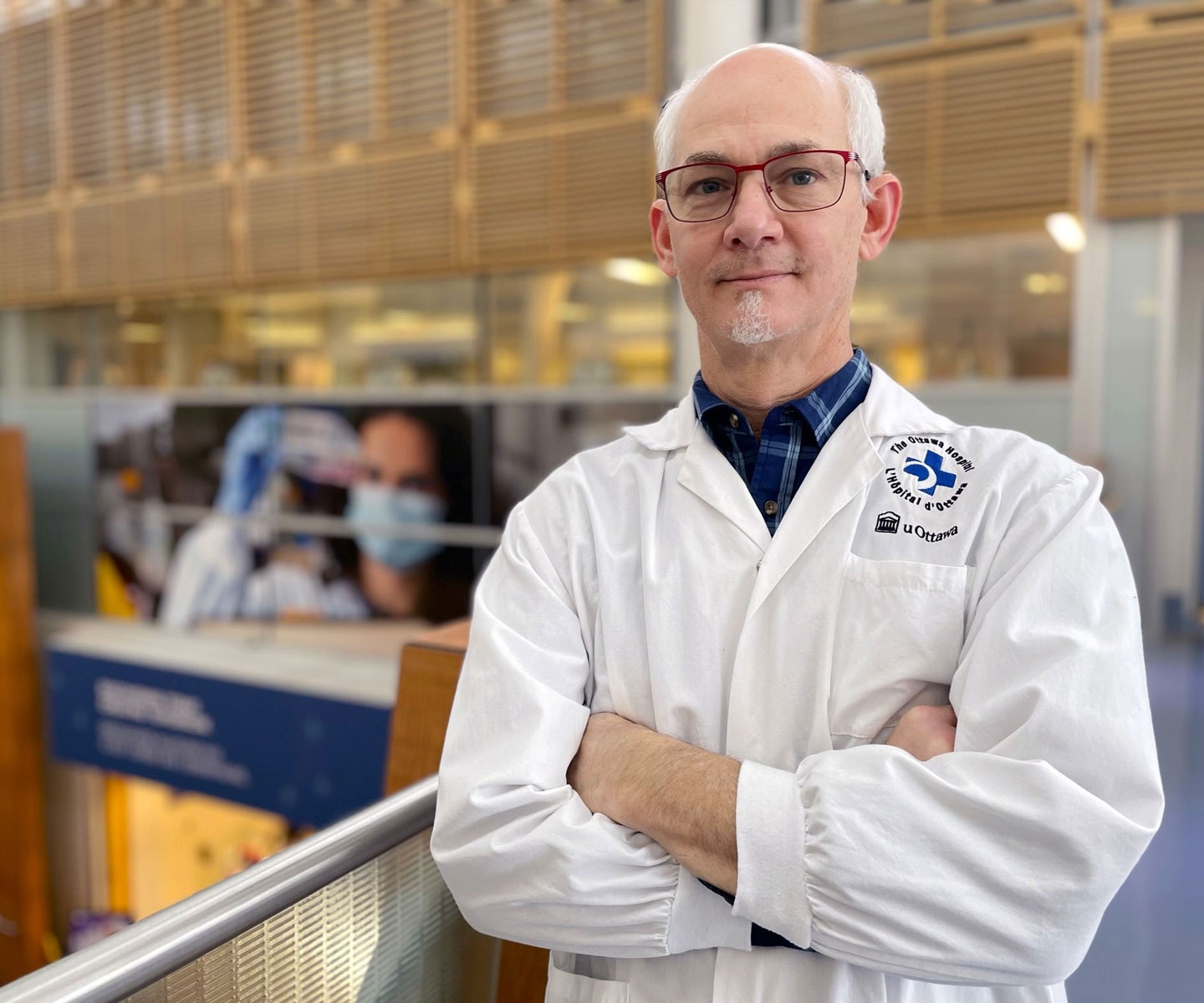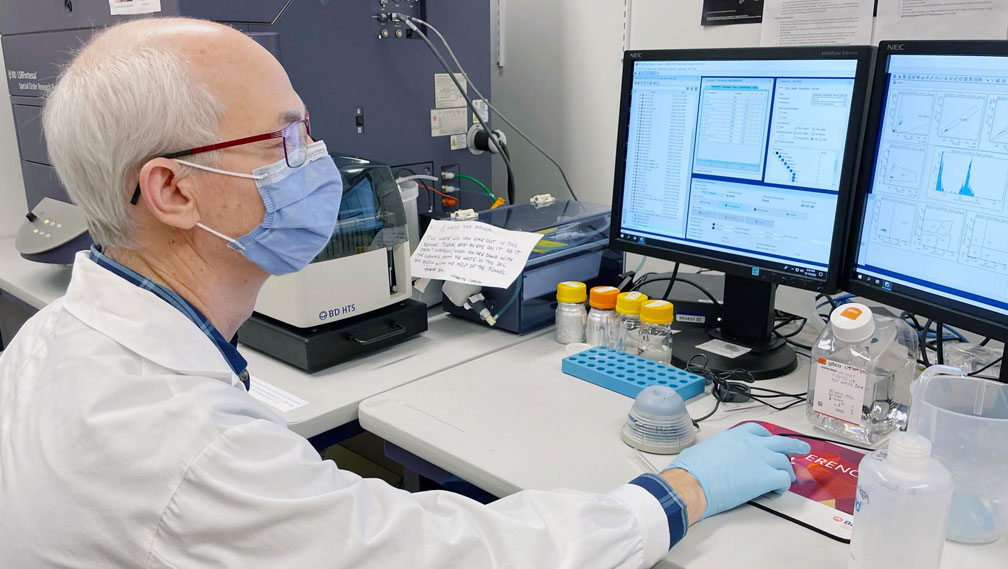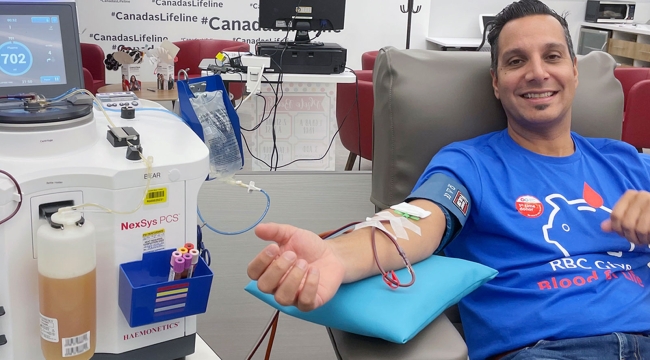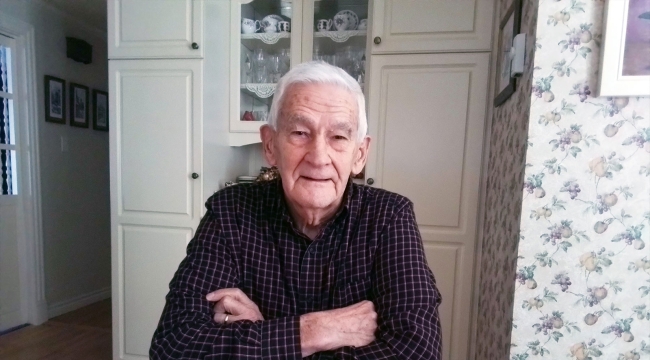‘Cord blood cells are priceless for us’

Cord blood donors help fuel Dr. William Stanford’s research and bring hope to leukemia patients
When you become a cord blood donor, you never know who you might help. The blood left in the umbilical cord and placenta after a birth is rich in lifesaving stem cells, which can be transplanted to cure blood cancers, life-threatening genetic disorders and more.
But with donor consent, cord blood donations can also take another meaningful path, through our Cord Blood For Research program. If a donation cannot be banked for transplant, such as when the quantity of stem cells is insufficient, this program can direct it to any of several researchers across the country.
“Cord blood cells are priceless for us, really, for the type of research that we do,” says Dr. William Stanford, a senior scientist at The Ottawa Hospital and professor at the University of Ottawa.
“Our own experience, and that of many of our colleagues, is that clinical trials that are being done now would not be in the clinic if it were not for cord blood cells.”
The research happening in Dr. Stanford’s lab could one day make all the difference for patients with acute myeloid leukemia — particularly the 30 to 40 per cent of patients whose disease does not respond well to existing chemotherapy.
The work revolves around a protein called MTF2, which is found in blood cells.
“What we discovered a few years ago is that leukemia patients who have a normal amount of MTF2 generally survive a much longer time following treatment with chemotherapy,” says Dr. Stanford, who also holds the Canada Research Chair in Integrative Stem Cell Biology.
“That made us want to try to figure out what’s going on — what MTF2 is controlling.”
Cord blood cells help advance understanding
In their search for answers, Dr. Stanford and his colleagues have used laboratory techniques to turn off production of MTF2 in cord blood stem cells. They have used those treated cells in experiments with mice, and also used insights from that work to develop experiments using leukemia cells from human patients.
In short, they’ve found that MTF2 controls “a lot,” says Dr. Stanford.
"Clinical trials that are being done now would not be in the clinic if it were not for cord blood cells” Dr. William Stanford, senior scientist, The Ottawa Hospital
For example, MTF2 plays a vital role in regulating cell survival versus death following DNA-damaging chemotherapy. When blood cells have normal levels of MTF2, they die when exposed to that chemotherapy. But when MTF2 is lacking, the cells repair themselves and continue replicating.
Not only do the cancer cells survive, they proliferate and wreak even greater havoc.
“Unfortunately, when a cell has been given chemotherapy and it repairs itself, it adds more mutations in the process. And then the cancer is even worse than it was before chemotherapy,” Dr. Stanford explains.

Unlocking the mysteries of MTF2
In digging deeply into the role of the MTF2 protein, Dr. Stanford and his colleagues have discovered important connections with other proteins: in particular, one called MDM2 and another called P53.
They’ve found that when blood cells are low in MTF2, they are also high in MDM2, because a particular gene is abnormally activated. And in turn, high levels of MDM2 are associated with low levels of P53.
That last fact was striking, because leukemia patients with a mutation in the gene that controls production of P53 were already known to be at high risk.
“This is the patient population that does the worst,” Dr. Stanford says. “Even with a bone marrow transplant, only one in ten of those patients survive more than a couple of years.”
To understand the relationship between these proteins, you can think of it like the human stress response.
- Not having enough time to finish tasks (low MTF2) is associated with high stress (MDM2)
- When stress (MDM2) is high, energy (P53) is depleted
- When energy (P53) is depleted, productivity (response to chemotherapy) is low.
Dr. Stanford and his team decided to focus on the “stress” part of the equation, MDM2. They knew of a particular class of drugs, called MDM2 inhibitors, that blocked production of MDM2. So just as a busy person (who can’t manufacture more time) might try deep breathing exercises to reduce stress, the researchers tested MDM2 inhibitors on cord blood cells.
The result? Not only did levels of MDM2 go down, but levels of P53 went up, making the cells vulnerable to chemotherapy.
Further experiments produce great excitement
The promising results in cord blood cells informed the next round of experiments, which involved testing MDM2 inhibitors in mice.
The researchers began by transplanting human leukemia cells to the animals. One group of mice received cells from patients who had responded well to chemotherapy. The second group received cells from patients with resistant disease (the type associated with higher levels of the MDM2 protein).
The mice then developed leukemia resembling that of their human counterparts and were treated with chemotherapy. As anticipated, the mice with resistant disease eventually died, while the others survived.
But when the researchers delivered both chemotherapy and an MDM2 inhibitor to mice in both categories, all of the mice lived.
“That got us really super excited,” says Dr. Stanford.
Cord blood donations are ‘a precious resource’
In fact, the team’s findings, which were published in 2018, paved the way for an ongoing clinical trial to evaluate the potential of MDM2 inhibitors for the treatment of leukemia. And as that proceeds, they continue to investigate the genes controlled by MTF2.
Dr. Stanford’s hope is that the work leads to more effective therapies for the most difficult leukemia cases, and possibly even less toxic treatments for others. And he’ll need to continue using cord blood donations to move it forward.
“They’re a precious resource. Researchers are thankful every time we get a sample,” he says. “It allows us to do research that we really couldn’t do otherwise.”
Interestingly, successful new therapies could in turn increase the need for both cord blood donations and donations of adult stem cells (such as from people who join the stem cell registry). That’s because for many leukemia patients, a stem cell transplant is the best hope of a permanent cure after initial treatment puts their disease in remission.
How you can donate cord blood
We collect cord blood at four hospitals in Canada. If you are planning to deliver a baby at any one of them, you can register in advance to donate to our national public cord blood bank. Then, immediately after the birth, one of our specialists will be able to receive the placenta and umbilical cord directly from hospital personnel — with no need to disturb you or your new arrival. If the cord blood can be banked, one of our specialists will visit you before you leave the hospital with a health assessment questionnaire.
Whenever possible, cord blood donations are stored for potential future transplants. But we encourage all donors to also give consent for their donation to be used for research. That way, in the event the cord blood cannot be banked, it may still make a lifesaving difference within Canada’s Lifeline.


